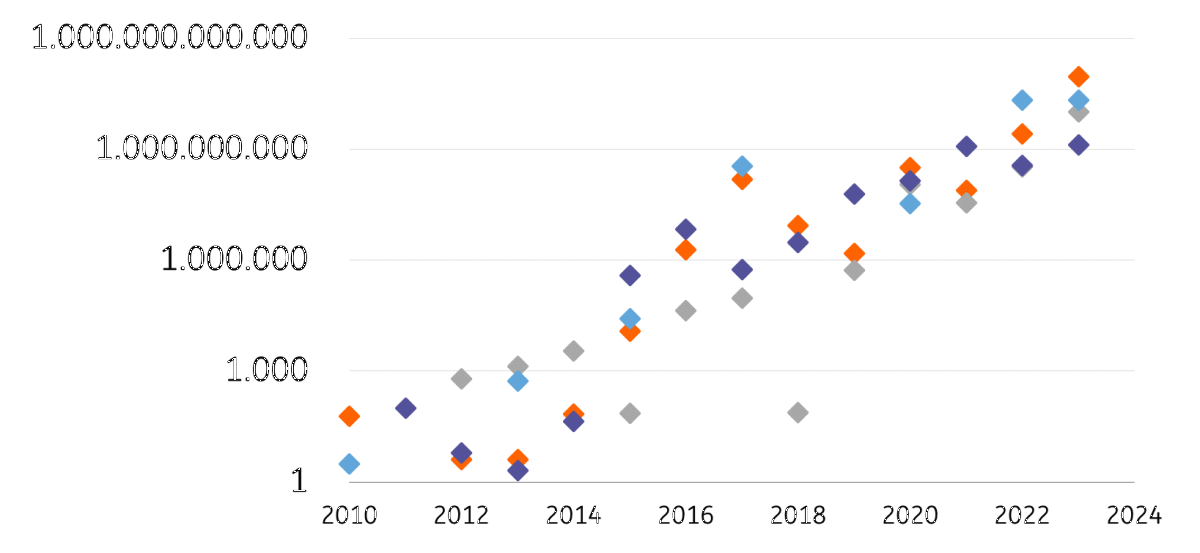AI Monthly: Soaring costs of GenAI challenge short-term profitability
New data suggests that AI is driving innovation and discovery beyond the Information and Communications Technology (ICT) sector. This is a promising sign, but there are growing concerns about the short-term returns on AI investments
Complementary innovation increases
Generative AI is considered a general-purpose technology, which is a technology that has a profound impact on the economy because it is pervasive, shows rapid improvement, and has the potential to drive complementary innovation across various economic sectors.
Recent research by Damioli et al. (2024) provides evidence for GenAI enabling complementary innovation. Between 2000 and 2016, global AI patenting accelerated significantly and became increasingly pervasive, with a notable shift away from the ICT sector to other areas of the economy.
Interestingly, this surge in patent activity was primarily led by relatively young and smaller companies, indicating that generative AI deployment fosters increased innovation.
Investment in LLMs still booming
The positive news about innovation is tempered by concerns about investment returns. Large language models (LLMs) have made exponential strides in recent years, but this progress has been accompanied by a corresponding exponential increase in training costs.
In 2017, training a top-of-the-line model cost roughly $1,000, but by 2024 that cost had risen to around $200m, despite a rapid decline in computing costs. The driving force behind this surge in training costs is the astonishing growth in computing power required by LLMs.
As model training data expands, the returns to scale in terms of model performance remain constant. This process therefore requires digital infrastructure such as data centres and ultrafast chips. If this trend continues, we could see the first trillion-dollar model before 2030. In addition, the largest investors in AI such as Amazon, Google, Meta, and Microsoft show no signs of slowing down.
Computing power used to train AI models
Computing power in Petaflop (logarithmic scale)

Concerns about investment returns increase
Given these eye-watering investments, it is no wonder that concerns about investment returns are also on the rise. However, estimates about AI’s impact on productivity growth vary. Initially, we predicted 0.1 to 0.5 percentage points of additional productivity growth per year, which is at the lower end of the scale.
But here’s the challenge: productivity growth tends to lag behind investment. Yet productivity growth is essential if these large investments are to be recouped. Recently, Martens (2024) highlighted a critical issue: our current investment trajectory is unsustainable unless productivity growth reaches 3% annually. This jump in productivity growth is not likely in the near term, as generative AI implementation requires time and investment from organisations that aim to use the technology.
Investors in AI face a difficult choice
The rapidly rising costs of generative AI are hard to match with near-term profitability. This confronts investors in AI with a conundrum: dial back investments and salvage near-term profitability or continue investing because expected future gains are too significant to miss out on.
Given the current AI race between the largest tech companies, we think it is unlikely that the largest investors in AI will hold back. Currently, this is feasible given their very profitable (cloud) businesses. Microsoft this week announced that cloud revenue in the second quarter rose 23% year-on-year. However, if current investment trajectories continue, the financial risks taken by these companies become ever-larger. This, in turn, poses an increasing risk to the financial health of these companies and a systemic risk for the tech industry.
Download
Download articleThis publication has been prepared by ING solely for information purposes irrespective of a particular user's means, financial situation or investment objectives. The information does not constitute investment recommendation, and nor is it investment, legal or tax advice or an offer or solicitation to purchase or sell any financial instrument. Read more
